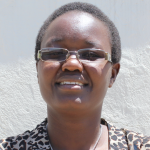"I have been drinking water from this source for more than 50 years. People are suffering from different types of waterborne diseases," said Mrs. Fatuma Shabani.
"Sometimes, we fear for what can happen to our health. I want my great-grandchildren to access clean and safe water now and in the future."
The 98 people living in this particular part of Mukoko rely on Mukoko Spring to meet all of their water needs. This natrual spring has a lot of water but it looks like milk. The source is completely open and unprotected, with animals coming and going to get a drink. Nonetheless, these people often have no other alternative for their drinking water. The water quality is not good, and we saw many small toads hopping in and out.
Mukoko Spring is located in a quiet, rural area that is well-vegetated. The community members farm to make a living, planting maize, sugarcane, beans, groundnuts, and sweet potatoes. The money earned from crop sales is always first applied to pay the children’s school fees. The buildings in this community are still very traditional, roofed with iron sheets and made of mud.
Community members wake up around 6am each morning. Women prepare children for school and prepare breakfast too, while men ensure that the compound is safe by walking around to ensure that nothing has been stolen. Breakfast is served at 9am and those who woke up and immediately go to the farm will come back to join the others.
Most people finish up their farm work by lunchtime at 1pm, leaving the afternoon to sell their crops at the local market or do chores at home. They freshen up for supper at 6pm, when the students are back home and able to help with fetching water for cooking.
Families here often work together to make sure their dirt roads are passable. They get a lot of traffic on these roads because they’re on the way to Rosterman, a big mining community.
Fewer than 10% of households have their own pit latrine. The latrines are dirty because it is difficult to clean the mud floors with water, so many community members just clean the toilet when they have visitors. There was no water nearby for someone to wash their hands after, but for the exception of one household.
The community is doing some things right, like ensuring that every home has a line for drying clothes. People give permission to those who have no latrine to use their own toilets to prevent open defecation in the community. Some of the community members need to own their own toilets because they are sharing, and sometimes it becomes a challenge at night when one is tempted to use the nearby bushes.
What we can do:
Training
Community members will attend hygiene and sanitation training for at least two days. This training will ensure participants have the knowledge they need about healthy practices and their importance. The facilitator plans to use PHAST (Participatory Hygiene and Sanitation Transformation), CLTS (Community-Led Total Sanitation), ABCD (Asset-Based Community Development), group discussions, handouts, and demonstrations at the spring. One of the most important topics we plan to cover is the handling, storage, and treatment of water. Having a clean water source will be extremely helpful, but it is useless if water gets contaminated by the time it’s consumed. Handwashing will also be a big topic.
Training will also result in the formation of a committee that will oversee operations and maintenance at the spring. They will enforce proper behavior around the spring and delegate tasks that will help preserve the site, such as building a fence and digging proper drainage. The fence will keep out destructive animals, and the drainage will keep the area’s mosquito population at a minimum.
Sanitation Platforms
On the final day of training, participants will select five families that should benefit from new latrine floors.
Training will also inform the community and selected families on what they need to contribute to make this project a success. They must mobilize locally available materials, such as bricks, clean sand, hardcore, and ballast. The five families chosen for sanitation platforms must prepare by sinking a pit for the sanitation platforms to be placed over. All community members must work together to make sure that accommodations and food are always provided for the work teams.
Spring Protection
Protecting the spring will ensure that the water is safe, adequate and secure. Construction will keep surface runoff and other contaminants out of the water. With the community’s high involvement in the process, there should be a good sense of responsibility and ownership for the new clean water source.
Fetching water is predominantly a female role, done by both women and young girls. Protecting the spring and offering training and support will, therefore, help empower the female members of the community by giving them more time and efforts to engage and invest in income-generating activities.



 Rehabilitation Project
Rehabilitation Project









































